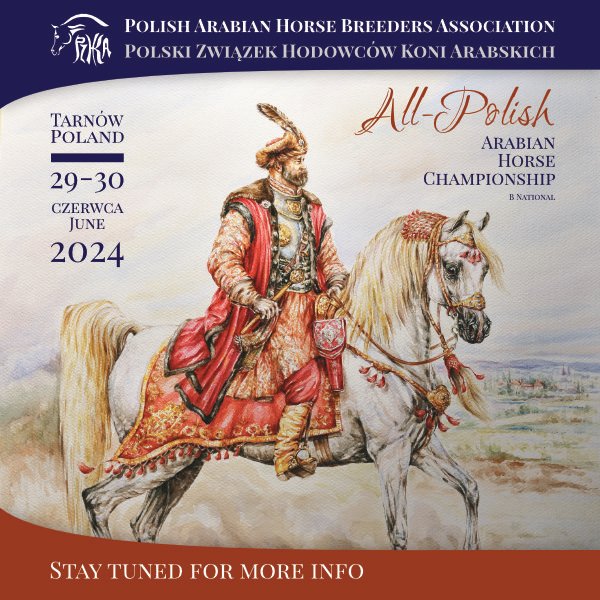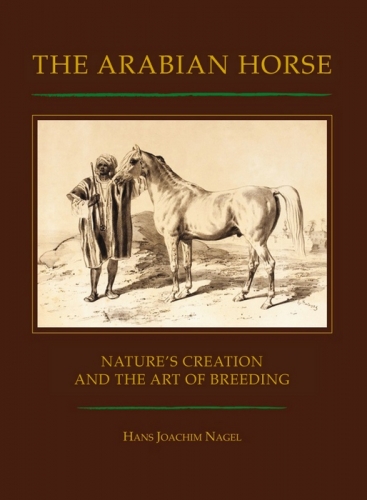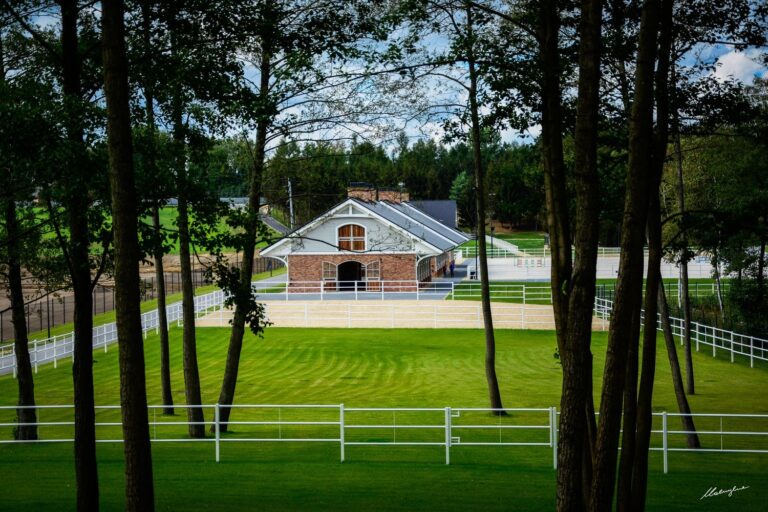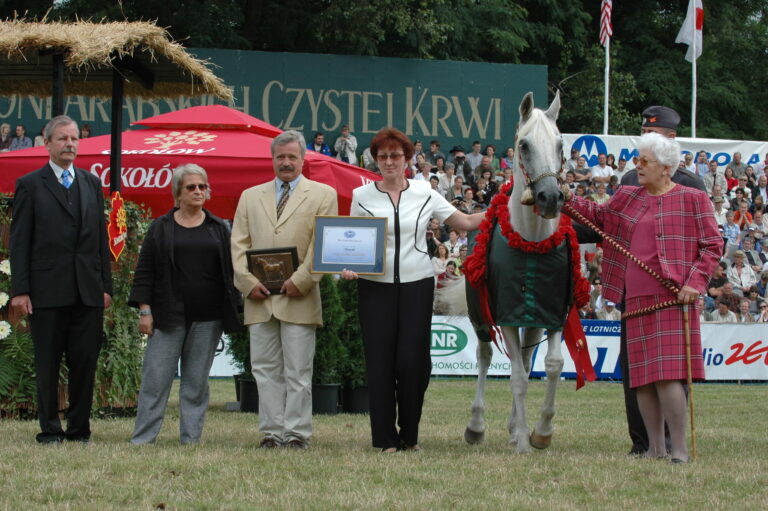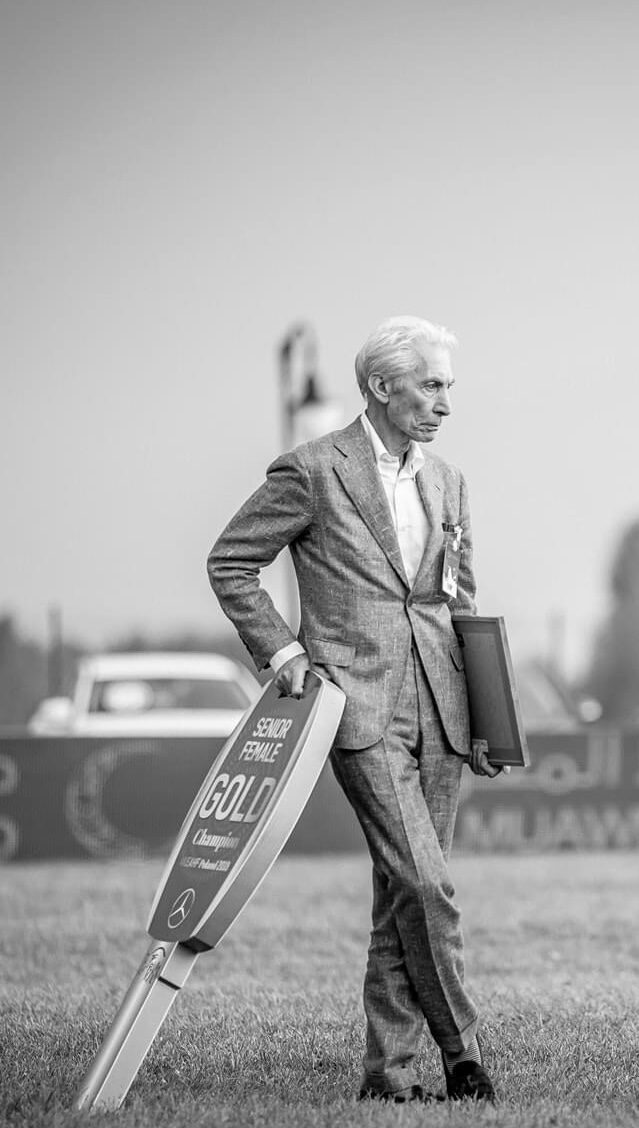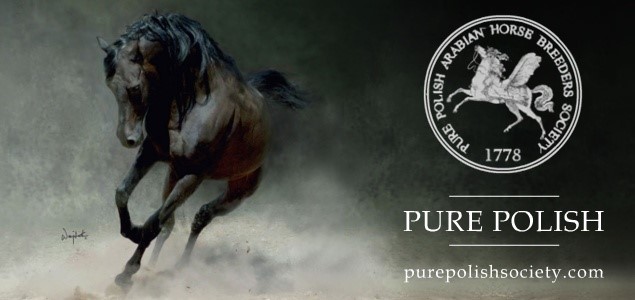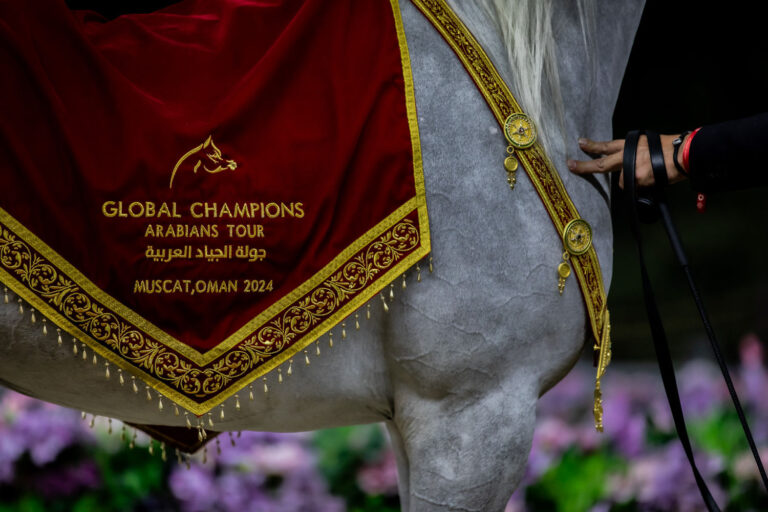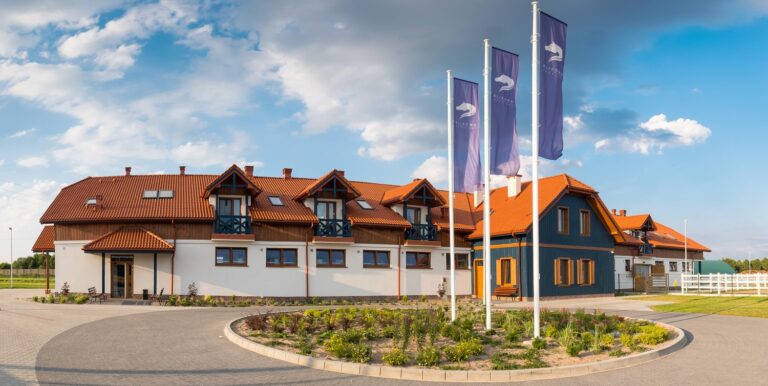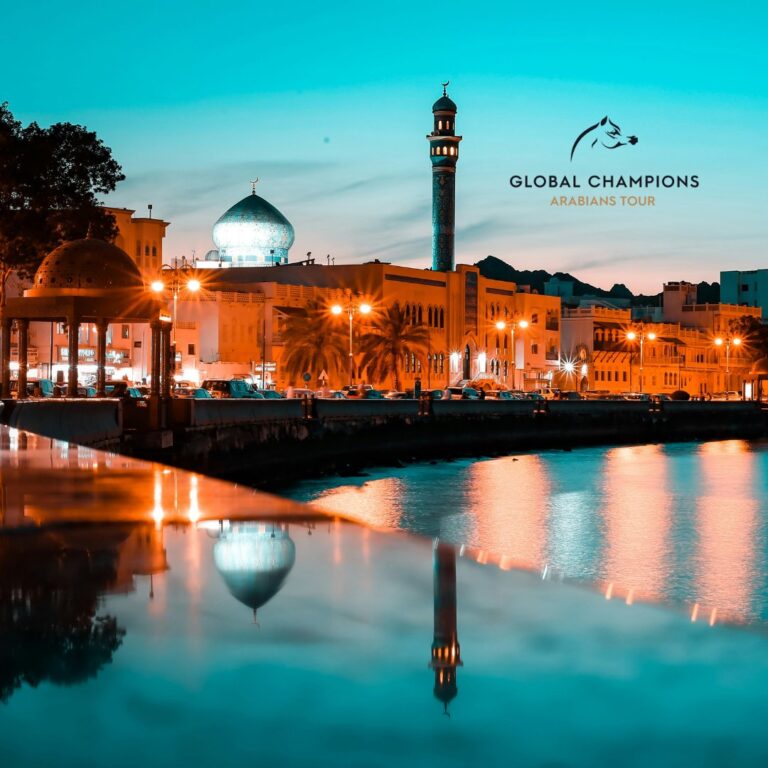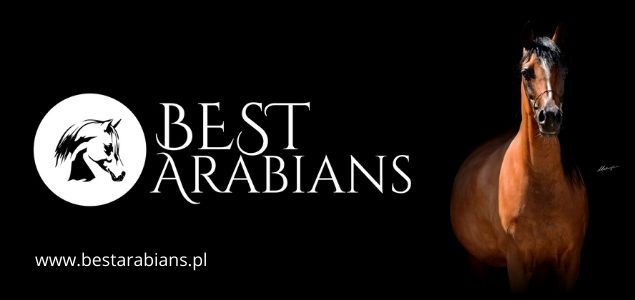Hans Joachim Nagel is a known persona in the Arabian horse community and one enjoying great authority – a many year breeder (born 1930), an author of books, an international judge, the president of the German Arabian Horse Association (VZAP) for 20 years and the president of WAHO for 10 years. His latest work – “The Arabian Horse. Nature’s Creation and the Art of Breeding” (published by Nawal Media) can without exaggeration be called monumental due to its broad subject matter, as well as the physical size of the volume. It’s one of those books that are a must-have for every Arabian horse enthusiast, be it a hands-on breeder or simply an avid supporter.
The author’s enormous experience and knowledge on Arabian breeding resulted in a truly impressive publication. From Egypt to Poland, from the US to Saudi Arabia – Nagel gives an account of his travels and observations. He reminds us about the roots of the Arabian horses, their first breeders – the desert Bedouins and confronts their customs with modern knowledge; recalling finally his own adventures regarding his stud Katharinenhof, located in northern Germany (where, as he writes, “farmers constantly monitor the sky for rain clouds, as the soil is sandy and dry”). He is also not afraid to point out the disturbing in his opinion occurrences that are a part of the Arabian industry today. The text is accompanied by plenty of illustrations and photographs, which gives the publication an album-like feel, whereas the diligence and beauty of the book will not leave anyone unmoved. The author used many sources – it is worth taking a look at the bibliography in order to find more reading inspiration.
Part I. Travelling from East to West
The author dedicates the first part of the book to the development of the breed over the centuries and Arabian horses from various corners of the globe, including those in Poland. “One of the perennial questions raised is”, he writes in the prologue, “whether the Arabian was shaped by guidelines for breeding handed down from its historical breeders, or whether the harsh environment and the consequences of the extraordinary way of the life of the Bedouins were primarily responsible for the development of this unique breed of horse. Perhaps the human influence in creating this Arabian was only marginal throughout its history”. What happened when the horse found its way into the hands of foreign breeders – this is also what this book is about. The author describes those breeding programs, which in his opinion had a significant influence on today’s Arabians.
In the chapter “Living with Arabians” he portraits the conditions in which the Arabian breed was formed. Those foreign travellers, which in the past traversed the desert lands of the Middle East, “returned with the experience that it would be better to keep one’s distance from this society, which has, by almost all the adventurers, been perceived as „lawless”, „troublesome” and „dangerous”. This closed society, however, was governed by their own rules and traditions, with awareness of these traditions, respect for their elder persons, care of children and a firm hierarchy, and most of all, by a total freedom, rejecting any official interference”. It was those people that had for centuries been accompanied by the horse, today known as the Arabian. When searching for information about this breed we cannot forget where this equine comes from, as it is fundamentally significant. “Attentive, alert, intelligent, with a sense of humour and with a very warm attachment to those people who love them, but an aloof attitude to those who do not, such is the nature of the Arabian horse”, the author emphasises.
Going back to the beginnings, in the chapter “Arabia – the Historical Homeland”, Nagel recalls the traditions nurtured by the Bedouins. Photographs published on a dozen pages depict the unique nature and landscape of the desert. The author stresses that “a precondition to be recognised as a member of the breed is the fact that each Arabian horse has to trace back to one of the great „strains” that are accepted and appreciated by the breeders in Arabia”. This is important in regard to the purity of the breed and characteristic traits. A key factor are of course stud books in each country where Arabians are being bred. Nagel mentions five of the most important strains: Siglavi, Hadban, Koheilan, Obayan and Hamdan and with the uttermost diligence describes six distinguishing marks of a “Southern type” Arabian. They are: strong, fully pigmented black skin, the tail being carried very high, an elegant concave face, a docile disposition and a special confidence in man, a dry and hardy appearance, the ability to improve other horse breeds and finally “fine bone with high density”. The “Northern type” is taller, sturdier and more athletic, it also doesn’t have to have fully pigmented skin, since that wasn’t required by environmental conditions in Syria, Iraq or Southern Arabia. After the collapse of breeding in the Arabian Peninsula, the great breeding comeback on those lands wouldn’t be possible, paradoxically, without importing Arabians from foreign countries, concludes the author. Nevertheless, as the author reminds us numerous times, the historic beginnings are the key to understanding what this breed is.
The advantage of damlines and the influence of stallions
“The war-like lifestyle of the Bedouin tribes undoubtedly required a fast, strong and agile horse and one gifted with stamina and power”, explains Nagel. Another decisive factor in selection was the horse’s “disposition”. We owe today’s temperament of the Arabian to the Bedouins, who paid great attention to “human-related behaviour”. Nagel calls this relation almost “symbiotic”: “man and horse needed each other, even if the role of the master was absolutely clear”.
“The historical Arabian Bedouin breeders strongly believed in the importance and superiority of a mare line. Modern research in genetics has confirmed this idea, and the influence of a mare on her foal is rated to be, at least, 10% higher than the influence of the relative stallion. Also, as a principle, the mares play the role of more permanent and conserving part. Her traits and characteristics are more solid, her structure more difficult to be changed, both in positive and in negative direction. Therefore, the choice of the mare line, with all its traits, is of a vital importance for success. To upgrade a mare line is difficult and can take generations”, he notices further. Therefore the ancient breeders of the Arabian Peninsula focused their efforts on female specimen. “All their thinking is concentrated on mares and mare lines, and stallions are not even mentioned. Their riding mounts were mostly mares, as stallions could be noisy and nervous, and therefore a risk in their silent attacks at night. This also means that they knew more about the performance of their mares than their stallions. (…) And such mares were called „blessed mares”, due to the quantity and quality of their foals; these mares were priceless”, Nagel adds.
A stallion’s role is to bring new, better, or additionally required improvements into the herd. (…) Body size is highly hereditable, fertility is low, tail carriage medium (…) It is apparently quite a common observation that the stallion has greater influence on the front part of a horse and the mare has more on the hind part”, he analyses.
In Europe
Among the seven breeding programs that have been fundamental for the development of the breed he mentions Polish and Russians state studs, Crabbet Park Stud in England, El Zahraa in Egypt, Weil/Marbach in Germany, breeding in France and the Hungarian Babolna, where basing on the Arabian they created a separate breed, the Shagya. Nagel devotes a separate chapter to Polish breeding, focusing mainly on the history of Janów Podlaski. It is not possible to present the entire history of Polish breeding in a book of such a vast subject matter, however Polish readers will feel a lack of Michałów Stud – this world famous stud received only a small mention. Yet enthusiasts of the Polish Arabian will definitely be interested in the lots of the mare Euni – a personal story in this part of the book.
Hans Nagel, together with his business partner, purchased the mare Euni 1973 (Bandos – Eunice/Comet) and bred her to his sire Jamil 1975 (Madkour I – Hanan/Alaa El Din). This mating resulted in the colt Vision 1980, foaled at Mulawa Arabian Stud (Australia), where the pregnant Euni was sold. The author says he had no intention of selling the mare, as she had plenty of charisma. However Greg Farell Sr., who was travelling across Europe in search of valuable broodmares, insisted on buying her. When Nagel directed him to other German studs, Farell returned several days later claiming that he didn’t find any mare of comparable value. The owner acknowledged the feeling that his guest felt towards Euni and finally decided to sell her. Her son Vision became a known sire in Australia. Her other produce, the colt Arrival and filly Mulawa Eunique (both by a Bask son, the stallion Ambition) have left their mark in breeding and at shows – Mulawa Eunique was the first Australian National Champion. According to the unanimous opinion of Nagel and Farrel, the stallion Ambition was to be a perfect partner for Euni and that’s exactly what he was. Euni (the dam of 14 foals), Vision and Arrival lay the foundations for a breeding program known today the world over.
Nagel devotes the next chapters to the remaining breeding programs. When writing about Tersk he emphasises that genetics have always been highly developed in Russia and in Arabian horse breeding the Russians remained focused on their principles and abode by strict rules, such as racing trials of young horses, the evaluation of mares in terms of productivity or mating mares with various sires to be able to choose the best option. Russian breeders highly believed in the classification of Arabians into three types: Koheilan, Siglavi and Hadban and were huge fans of “cross breeding”. Analysing the history of Russian breeding the author doesn’t remain silent on the fact that plenty of valuable material was robbed from Janów Podlaski in 1939. He also recalls that in the 50s “Polish/Russian relationship improved, and a positive cooperation between the two countries started again”, which can cause astonishment in a Polish reader, more familiar with the history of both nations. Perhaps that’s how it looked like from the outside? Since the son of Amurath Sahib – Arax – found his way to Russia… Among the milestones of that breeding the author also mentions the Egyptian-imported sires Nil (by Sid Abouhom) and Aswan (by Nazeer).
The Babolnian herd, existing since 1789, produced mainly sturdy, strong horses in Arabian type, according to the author. Pure blooded sires were used there mainly to improve the quality of other breeds, not to develop the breeding of Arabian horses. As we know, the communist system after the World War II did not promote Arabian horse breeding, which was especially meaningful, although the author omits this aspect. As a result of those politics, in 1956 there were only two pure blooded Arabian mares left in Babolna. It was not until the 60s of the last century that new Arabian blood was imported to Babolna, also by means of Hans Nagel himself. It is a very interesting story, not known to many people. It resulted in Babolna returning to the Arabian horse breeding map and a 30 year old collaboration with Katharinenhof – yet another very personal recollection of the author.
Crabbet Park (where great services were rendered by the Polish Skowronek) was the fourth most important stud in Europe. In a chapter dedicated to this stud the author devotes a lot of words to Lady Anne Blunt, an English aristocrat greatly respected among the Bedouin tribes, who at the end of the 19th century became famous as an Arabian horse and desert life expert. Her and her husband’s (Wilfred Blunt) adventures in the Middle East can be compared to, as Nagel puts it, the story of Lawrence of Arabia. Beside valuable imports Lady Anne made detailed notes and kept journals from their travels, thanks to which her observations on Arabian horses are a valuable historic source. For many years (more than 90, up to its closing in 1971) Crabbet Park practically served as a national Arabian stud in the United Kingdom. A detailed history of this herd is definitely one of the most interesting parts of the entire book. “This chapter should not be closed before mentioning that Crabbet Park breeding had the highest influence among all breeders throughout the world, being the first and a pioneer for the introduction of the modern Arabian horse into most of the Western countries”, the author sums up. “Many of the early Arabian breeders started with Arabians which had been bred at Crabbet Park and from there on grew the great interest in Arabian horses which reached its zenith in the 1980s”.
The German stud of Weil/Marbach is known to every Arabian horse fan thanks to the famous Bairactar. There is a Polish thread in the history of this stud, connected with Emir Rzewuski, who searched for horses in the desert for them. Weil/Marbach was known for tens of years for its valuable imports and had a significant meaning for Katharinenhof, as Hans Nagel used their Egyptian imported sire Ghazal (by Nazeer) on his own mares. Two hours after covering the mare Hanan Ghazal died in a tragic accident. Out of this mating resulted the filly Ghazala, which became one of the most valuable broodmares at Katharinenhof.
France is a land of excellent mounts and racing horses, as most of the breeders focused on that kind of equine usage. “Most of these horses are quite different in their structure and type, compared to the type of Arabian horse which is generally considered the „classical” Arabian”, the author points out. “They are mostly long-legged horses with a long neck and the length of their backs is quite an evident feature as well. The croup is rather short in comparison to their back, but still strong. Their chest is surprisingly narrow”.
In Egypt
The Arabian horse in Egypt is mainly associated with El Zahraa, a stud established in the early 20th century. “It is the original source of all horses which are called „Straight Egyptian Arabians””, says the author. It is totally different from the previously mentioned European herds. “This stud has operated practically as a closed population for more than 60 years, and therefore the genetic relationship between their horses must be much closer”. As Hans Nagel explains: “El Zahraa’s primary intention was to breed a fine, elegant Arabian, deeply rooted in Arabian culture”. “It is believed that the Bedouin breeders”, he writes on “already understood the necessity to breed equal to equal, or at least similar to similar. In such a closed population as El Zahraa, such principles had already worked very successfully, since most of their horses had shown a great similarity in type”.
In the USA
America is a land of horses – says the author – thanks to vast grounds, long distances, great prairies and pastures. Arabians came here in the mid-19th century. Their later history is connected with such names as Davenport, Huntington and Babson and after World War II – LaCroix or Kellogg. During the breeding boom, a result of tax reliefs, about 30 thousand foals were born in the US each year. This situation caused a great overproduction of horses, the decrease of their quality and bankruptcy. Today 5 thousand foals are born in the US per year, making the country still one of the largest markets in this business. It is there that breeding is referred to as “the Arabian horse industry”, it is there that the most effective reproduction methods were conceived, the best feeding methods, the best promotion and the organisation of large shows. The American standards had a great influence of European shows, which from humble inspections turned into glamour spectacles and modern reproduction methods (artificial insemination, embryo transfer) took the world by storm. It was in the States that syndicates were born, groups of people owning the most valuable horses, especially stallions, that became superstars covering hundreds of mares. Those “super stallions” usually originated from European or Egyptian breedings, but achieved superstardom in the States they thanks to a highly efficient promotion machine. British (Raffles), Egyptian (Ansata Ibn Halima, Morafic, in later generations Ruminaja Ali, Anaza El Farid and Thee Desperado, Ali Jamaal), Polish (Bask, El Paso, Eukaliptus), Russian (Salon, Padron and his descendants, from Padrons Psyche to WH Justice) and Spanish (El Shaklan) bloodlines contributed to creating powerful dynasties in the US. According to Nagel, the American concept of sires having an advantage over mares has two consequences. First of all, new breeders have a chance at a quick success, though it is not predictable; it requires having a lot of mares and breeding them to various, currently fashionable sires. Out of a great number of foals only a couple will have a show career. Second, frequent cross-breeding makes the horses become more and more taller. The American market likes horses of large sizes and this trend is starting to get out of control today. Additionally, trainers in America are a power to be reckoned with. They hold the strings of the breeding and show business, which is another trait that distinguishes the American world of Arabian horse breeding.
Despite some reservations, Nagel stresses that even in the US there were important breeding programs that guarded the quality standard of the breed and had a worldwide influence on breeding. He acknowledged Ansata Arabians of Donald and Judith Forbis and Al Marah Stud (Tucson, Arizona) of Bazy Tankersley and devotes vast, separate descriptions of these herds.
Show, breeding and standard
This is the most critical part of Nagel’s book, who – as I mentioned previously – notices many disturbing occurrences in the world of shows. First of all, there is no longer any room for enthusiastic amateurs. It is a narrow, highly specialised business, remaining totally in the hands of professionals. This was determined by great money from the selling of victorious horses, as well as breedings to the trendiest sires. The breeding decisions of the owners are more and more influenced by professional trainers and marketers, as well as shows, which have created a group of super stallions such as Gazal Al Shaqab, Marwan Al Shaqab and WH Justice. For years the number of sires used in the world is shrinking and the influence of the trendy ones is growing. Whereas the amount of horses participating in shows is only about 5% of the entire population.
Apart from trainers, modern Arabian horse breeding is also influenced by judges, who no longer come from a group of experienced breeders, but from among people that have successfully completed a judging course. These judges try to “adjust” their marks to the prevailing standard of the breed, which rules out richness and variety within one breed. This standard (what is this standard? – the author tries to answer this question) leaves no room for discussion, so important in breeding. And anyway, many experienced breeders don’t agree with the scores of the judges. The awarded marks cannot reflect whether the horse possesses such a once important breed trait as a “gentle disposition”. Among other unfavourable happenings that the author notices is a tendency to breed champions to champions, without a deeper analysing of pedigrees, which results in a short-lived, one-time success, after which subsequent generations cease to exist.
“The true Arabian horse” has far more to offer than to just match a show standard”, the author concludes. “People have different tastes, and there never was and never will be only one standard in beauty or elegance. Standards become boring after a while, but regrettably, such a trend towards standardisation is a deplorable fact in modern life”.
Part II. Katharinenhof
In Part Two of his publication Nagel focuses on Katharinenhof stud (with 15-17 broodmares and 4-5 stallions), its breeding program, its history based on Egyptian lines, described here in great detail and the guidelines that he has been following for several generations of Arabian horses. He also shares his vast knowledge on genetics (inheritance, dominance, recessivity, nickability), breeding methods (inbreeding, line breeding), complications and risks associated with the choosing of each one; he also explains what pure breeding is. It is a very deep analysis which offers a great comparative material for every breeder. Is our awareness of historical roots of this breed just as strong? Is our knowledge about its characteristic traits and breeding preceded by deep research? Are the choices that we make based on experience, observation and science? Those are the questions that we should ask ourselves reading Hans Nagel’s Magnum Opus. If we discover that we’re lacking in a certain field, this book will definitely fill in our gaps, especially since the author ends his book with advice for new breeders – how to choose horses for breeding, what to pay attention to, where to expect the most difficulty.
“I was fortunate enough to enjoy step by step all these experiences and learning to know that this Arabian breed is unique: It has a fascinating history, loaded with fabulous stories and sprinkled with a good portion of romance. (…) These Arabians have the power to lead people away from drudgery and the pressures of modern life into the realm of delightful variations and an always refreshing encounter with an affectionate, truthful, but still proud creature”, we read in the final words of the book. A book about a great adventure, which every breeder of these amazing creatures has a chance to experience.
Hans Joachim Nagel, “The Arabian Horse. Nature’s Creation and the Art of Breeding”, Nawal Media 2013; 537 pages


